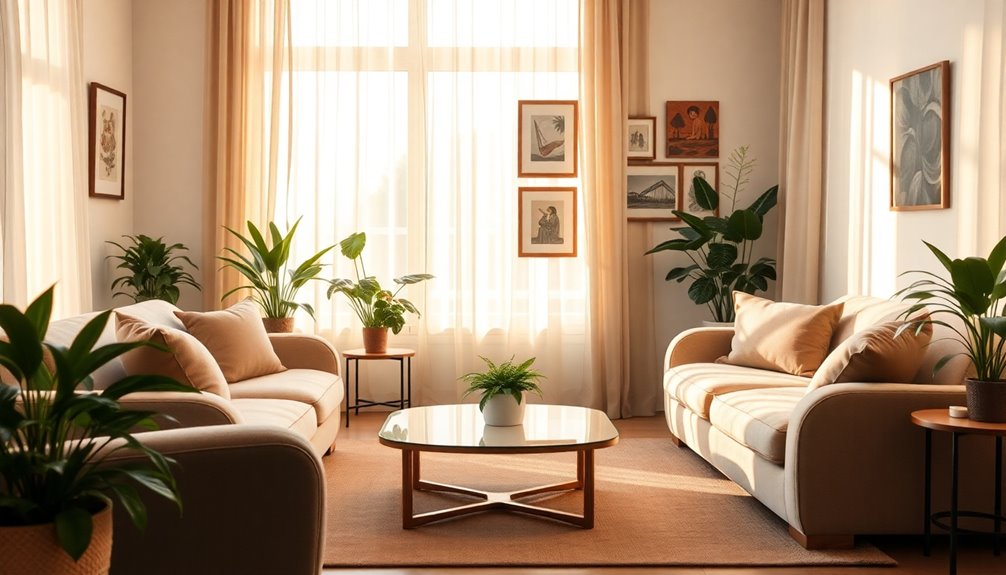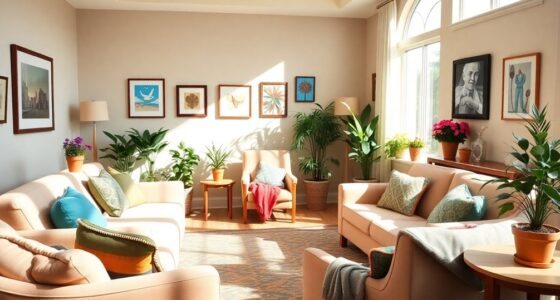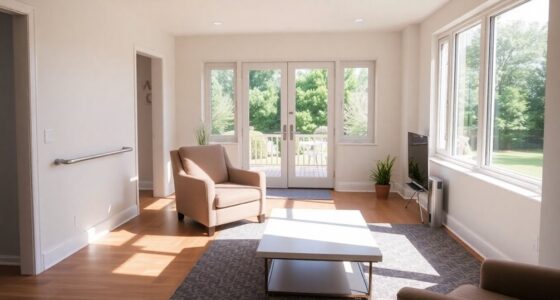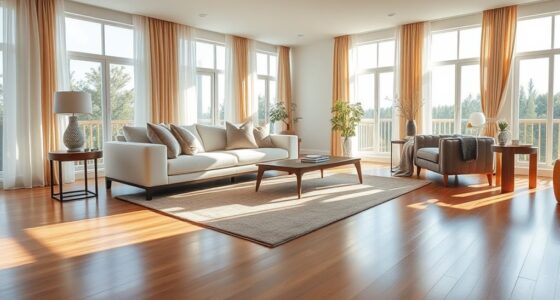To create a vibrant and supportive space for contemporary elderly living, focus on functional and accessible designs. Prioritize wider pathways, utilize comforting decor, and maximize natural light. Incorporate technology for convenience and consider flexible furniture arrangements for various needs. Personalizing living spaces with sentimental items fosters connections, while multi-purpose common areas encourage socialization. Sustainable choices enhance both comfort and the environment. Stick around to discover even more inspiring design trends to elevate elderly living! In addition, integrating outdoor spaces encourages a connection with nature, enhancing the overall well-being of residents. Furthermore, incorporating security features like grab bars and non-slip surfaces ensures safety without compromising style. For those seeking to enhance their living experience, these interior design tips for seniors can transform homes into welcoming havens that cater to their unique needs and preferences.
Key Takeaways
- Prioritize functional and accessible spaces with wider pathways and adjustable furniture for ease of movement and independence.
- Create a comfortable atmosphere using warm colors, personal decor, and cozy nooks to foster emotional connections and relaxation.
- Integrate technology, such as voice-activated assistants and smart home devices, to enhance safety and support daily tasks.
- Maximize natural light and use calming color palettes to promote well-being and improve mood in living spaces.
- Choose sustainable and eco-friendly materials, like recycled furniture and energy-efficient appliances, to create stylish and environmentally conscious homes.
Functional and Accessible Spaces
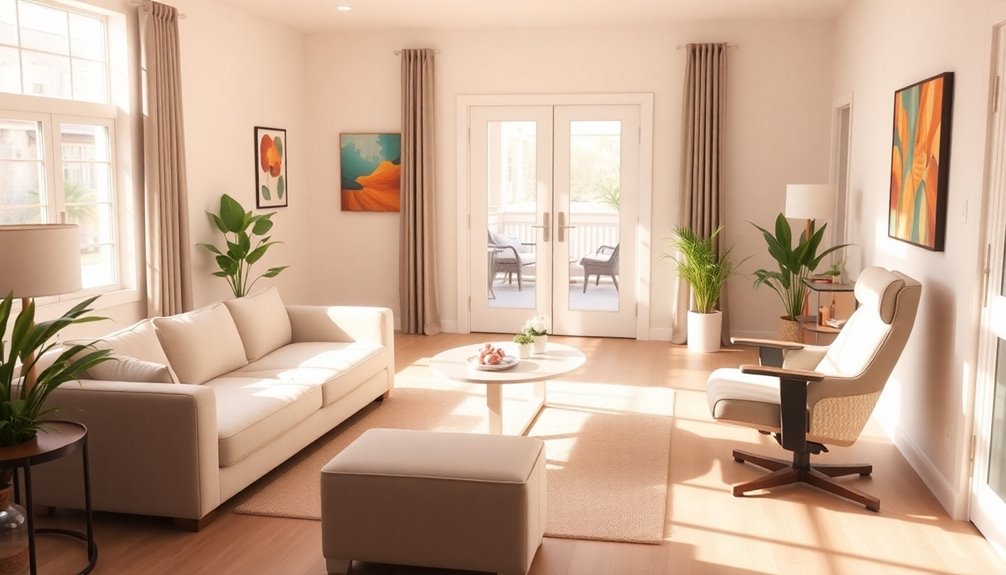
Creating functional and accessible spaces is essential for ensuring that elderly residents can navigate their homes safely and comfortably.
In senior living interior design, prioritize safety in interior design by incorporating wider pathways of at least 36 inches. This width accommodates walkers and wheelchairs, making navigation easier.
Opt for round furniture to minimize sharp edges and promote an open layout, reducing accident risks. Avoid decorative rugs to eliminate tripping hazards.
Additionally, consider furniture with adjustable heights and easy-to-reach storage to simplify daily tasks and support independence.
Practical features like lever-style door handles and pull-out shelves enhance usability, ensuring that every aspect of the space contributes to a safe and accessible environment for seniors. Incorporating natural materials like wood can further enhance the warmth and comfort of the living space.
Comfortable and Home-like Atmosphere

Creating a comfortable and home-like atmosphere starts with incorporating personal mementos and familiar decor that resonate with your memories. Using warm colors and soft textures can evoke positive emotions, making your space feel inviting. Additionally, incorporating natural elements like wood and stone can enhance tranquility and warmth in your living environment.
Personal Mementos and Decor
When you incorporate personal mementos and decor into an elderly living space, you foster a familiar and comforting atmosphere that can greatly enhance well-being. These elements not only create a home but also nurture a sense of community among residents. Here are some ways to achieve this:
- Display family photos on walls and counters.
- Showcase cherished artworks or heirloom pieces.
- Include favorite textiles for a personal touch.
- Create a gallery wall that reflects individual histories.
- Use decor items that evoke positive memories.
These personal mementos strengthen emotional connections and considerably improve seniors' overall comfort. Additionally, incorporating elements of self-care practices can further enhance the emotional and mental wellness of elderly residents.
Familiar Colors and Textures
A cozy atmosphere in elderly living spaces can be achieved through the thoughtful use of familiar colors and textures. Soft blues and earthy greens evoke calmness, enhancing your overall comfort.
By incorporating textures like cozy fabrics and warm wood finishes, you create a sense of nostalgia and belonging. Personalizing your decor with favorite quilts or family heirlooms adds emotional comfort, reinforcing your identity.
Research shows that maintaining a familiar environment with comforting colors and textures greatly reduces anxiety and promotes mental well-being.
Additionally, using color contrast in furniture and decor improves visibility and navigation, ensuring both safety and comfort in your living space. Incorporating natural materials like wood and linen can further enhance this comforting aesthetic.
Embrace these elements to cultivate a welcoming and serene home for yourself or loved ones.
Warm and Inviting Atmosphere
To cultivate a warm and inviting atmosphere in elderly living spaces, personal touches and thoughtful decor play an essential role. You can create a space that feels like home by incorporating sentimental items and warm design elements.
Consider these ideas:
- Use warm color palettes to evoke comfort.
- Display family photos and cherished artwork for familiarity.
- Create cozy nooks with soft seating for relaxation.
- Opt for soft, ambient lighting over harsh overhead fixtures.
- Include textured fabrics like throws and cushions for added warmth.
Incorporating natural materials like wood and stone can also enhance the overall warmth and authenticity of the space. These elements not only enhance emotional well-being but also promote a sense of continuity.
Use of Natural Lighting and Colors
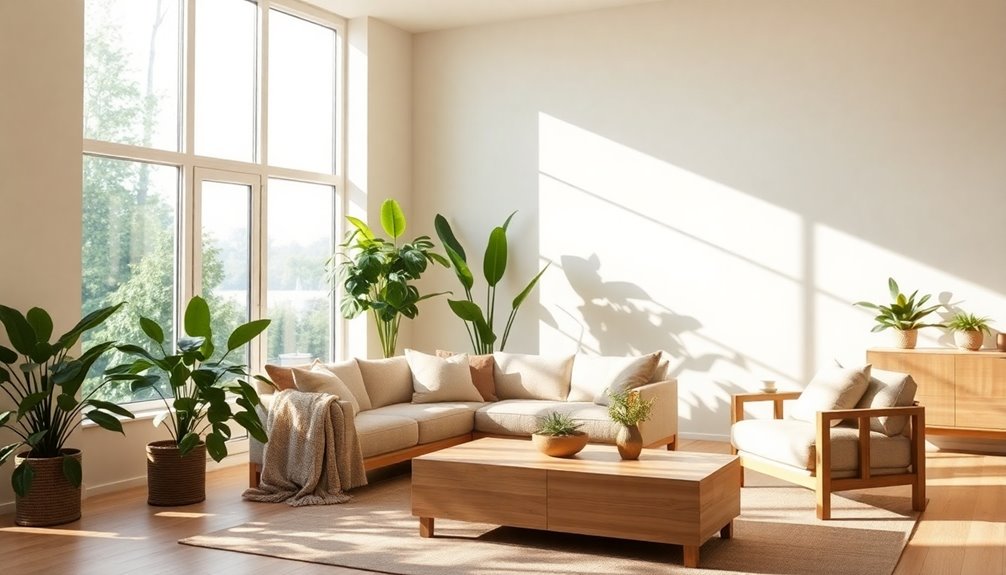
Natural lighting plays an essential role in creating a comfortable living space for seniors. By incorporating large windows and positioning furniture to maximize light exposure, you can enhance mood and alertness.
Pair this with calming color palettes like soft blues and greens to foster a serene environment that promotes relaxation.
Enhance Comfort With Light
When you prioritize natural light in elderly living spaces, you're not just enhancing the aesthetic; you're also boosting mood and cognitive function. By maximizing natural light, you can greatly improve your quality of life.
Here are some tips to enhance comfort with light:
- Position furniture to avoid blocking windows.
- Add large windows and skylights for unobstructed sunlight.
- Use soft blues and greens to promote relaxation.
- Incorporate brighter colors in dining areas to stimulate appetite.
- Foster a connection to the outdoors to improve mental health.
These strategies can help reduce feelings of isolation and depression, making your senior living spaces feel more inviting and vibrant. Embracing natural light is essential for creating a comforting environment, as it aligns with the principle of vibrational alignment to enhance overall well-being.
Calming Color Palettes
As you create a serene living space for seniors, choosing calming color palettes plays an essential role in fostering relaxation and well-being.
Soft blues and nature-inspired greens can greatly enhance comfort in senior living communities, promoting a peaceful environment.
Consider incorporating brighter colors in dining areas to stimulate appetite, especially for those with reduced food intake.
Utilize natural elements and ample natural light through large windows to improve mood and alertness, making the space feel inviting.
Additionally, guarantee high-contrast colors between surfaces to aid navigation and reduce fall risks, helping seniors distinguish different areas.
Moreover, maintaining a clean environment can reduce allergens and pollutants, contributing to a healthier living space for seniors.
Making Life Easier

To enhance daily living for elderly residents, it's essential to create an environment that prioritizes accessibility and safety.
In a senior living community, thoughtful design elements can greatly accommodate changing needs.
Consider these practical updates:
- Position frequently used items within easy reach to minimize bending or stretching.
- Replace traditional round knobs with pulls and levers for better accessibility.
- Guarantee sturdy furniture is placed to provide balance support and reduce fall risks.
- Rearrange living areas to create wider pathways for easier navigation with mobility aids.
- Incorporate adjustable shelving and pull-out drawers to simplify daily tasks.
- Additionally, incorporating sensory toys can provide engaging activities that support cognitive development and emotional well-being.
Integration of Technology and Digital Tools
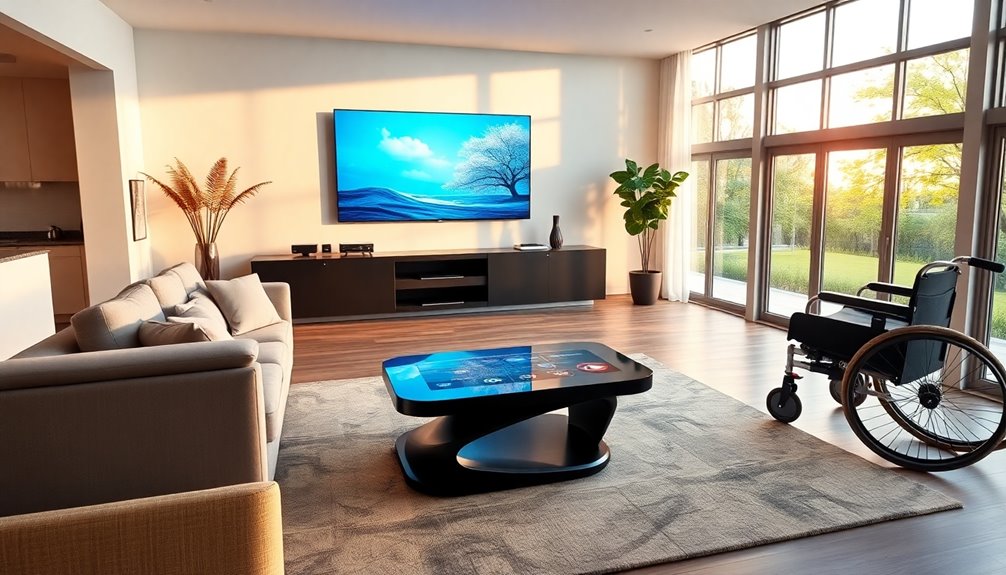
Incorporating technology into elderly living spaces not only enhances convenience but also fosters independence. The integration of technology, like voice-activated assistants, lets you manage daily tasks hands-free, making life easier and more enjoyable.
Smart home systems can automatically adjust lighting and temperature, creating a comfortable atmosphere tailored to your preferences. Wearable devices with location tracking offer peace of mind, ensuring safety in case of emergencies.
Telehealth options give you easy access to healthcare professionals without leaving home, and digital tools encourage social connections through video calls, keeping you engaged with loved ones despite physical distance.
Embracing these advancements transforms your living space into a tech-savvy haven that supports your lifestyle and well-being.
Nature-Infused Interiors
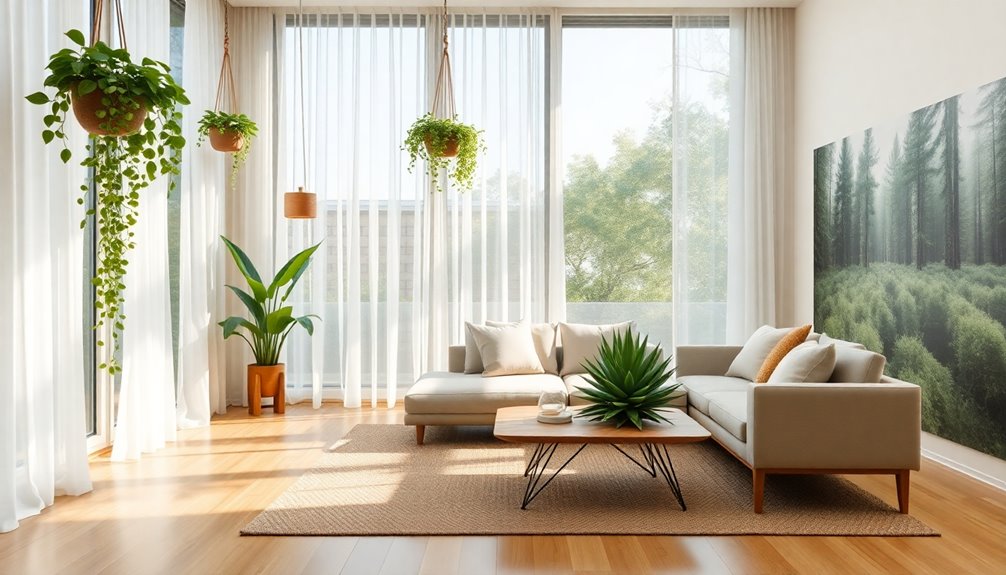
Blending technology with nature can create a harmonious living environment that promotes well-being for seniors. Nature-infused interiors, featuring elements like indoor gardens and living walls, are essential for enhancing mood and reducing stress.
You should consider these key aspects:
- Maximize natural light with large windows to boost alertness.
- Incorporate plants to improve indoor air quality and respiratory health.
- Utilize natural materials for a calming aesthetic.
- Include nature-themed decor for cognitive function and emotional resilience.
- Create access to outdoor spaces to encourage physical activity and social interaction.
- Integrate smart technologies such as energy-efficient water systems to promote sustainability and ease of use for seniors.
Flexible Furniture Arrangements for Various Purposes
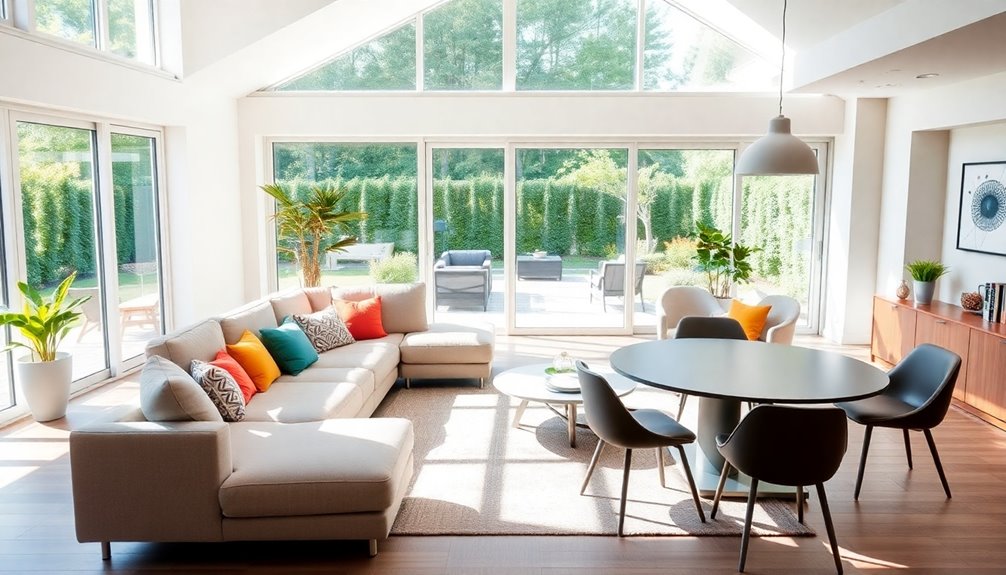
As you consider the needs of elderly residents, flexible furniture arrangements can greatly enhance their living experience. Utilizing modular furniture allows you to create adaptable spaces that cater to various activities, from gatherings to quiet relaxation. Lightweight pieces promote flexible layouts, providing autonomy for seniors.
Here's a table to illustrate some options:
| Furniture Type | Purpose | Benefits |
|---|---|---|
| Modular Sofas | Social gatherings | Easily rearranged |
| Nesting Tables | Dining and leisure | Space-saving versatility |
| Stackable Chairs | Extra seating | Quick setup and storage |
| Foldable Desks | Workspace | Adjustable and portable |
Incorporating these elements helps maintain a clutter-free environment, ensuring easy access to necessary items. Additionally, choosing durable materials can enhance the longevity and ease of maintenance for furniture in elderly living spaces.
Personalization of Living Spaces
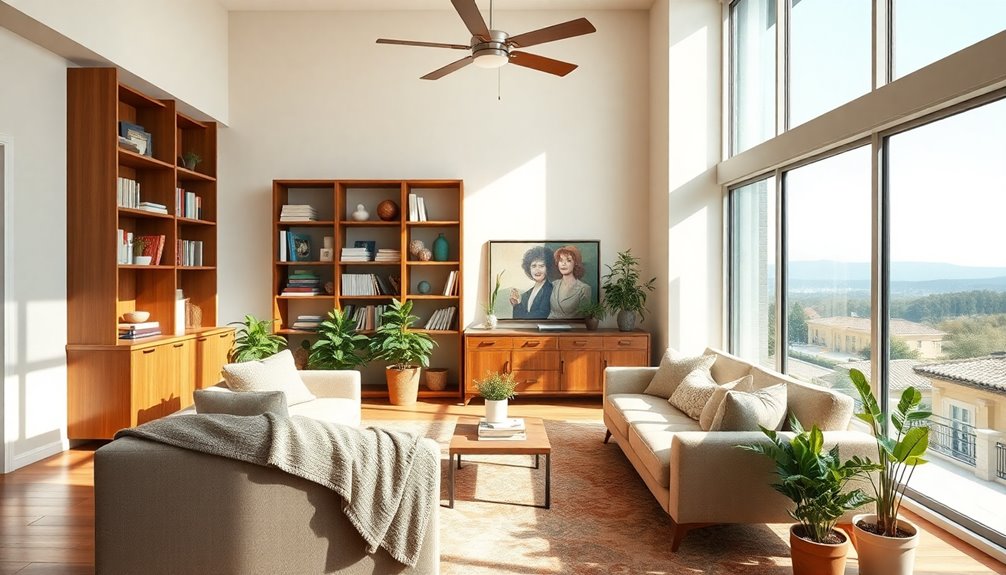
Creating flexible furniture arrangements sets the stage for a more personalized living space, allowing seniors to truly make their homes their own.
Personalization fosters comfort and a sense of community, reflecting individual tastes and preferences. Here are some ways to enhance your living space:
- Display family photos and cherished collections to strengthen emotional connections.
- Incorporate custom artwork and heirloom pieces for sentimental value.
- Use favorite textiles and familiar decor to evoke positive memories.
- Thoughtfully organize belongings to declutter while showcasing meaningful items.
- Create cozy nooks for relaxation and social interaction.
Multi-purpose Common Areas for Socialization

While multi-purpose common areas play a crucial role in fostering community among seniors, they also serve as vibrant hubs for socialization and engagement.
These multi-purpose rooms are designed to host a variety of activities, like yoga classes, movie nights, and community meals, enhancing social interaction among residents. With flexible furniture arrangements, you can easily adapt the space for different events, making it more inviting.
Incorporating kitchens and art studios encourages participation in cooking demonstrations and creative workshops, promoting a sense of belonging.
Outdoor extensions like gardens or patios provide additional venues for gatherings, enhancing your connection to nature and each other.
Research shows that these communal spaces greatly improve mental health, reducing feelings of isolation and loneliness within the senior community design.
Sustainable and Eco-friendly Design Choices

When you think about sustainable design for elderly living, consider how energy-efficient materials can cut down on utility costs.
You can also explore recycled furniture options that not only look great but help the environment.
Adding indoor plants can boost air quality and enhance the overall atmosphere, making it a win-win for everyone involved.
Energy-Efficient Materials
As you evaluate design choices for elderly living spaces, incorporating energy-efficient materials can make a significant impact on both comfort and sustainability.
These materials not only benefit older adults but also promote a healthier environment. Here are some effective options to evaluate:
- LED lighting for reduced energy consumption
- Energy Star-rated appliances to lower utility bills
- Eco-friendly insulation for enhanced thermal comfort
- Double or triple-glazed windows for better natural light and heat retention
- Low-flow fixtures to save water and promote sustainability
Recycled Furniture Options
Recycled furniture options are transforming elderly living spaces into stylish, eco-friendly environments. By utilizing sustainable materials like reclaimed wood, recycled plastics, or metal, these pieces not only reduce waste but also lower the demand for new resources.
Choosing recycled furniture is an eco-friendly choice that supports local artisans and businesses specializing in upcycling, fostering community engagement and economic sustainability. Plus, the durable designs of recycled furniture guarantee longevity, making them perfect for budget-conscious seniors who want to avoid frequent replacements.
Incorporating these options not only promotes sustainability but also allows you to create unique living spaces that reflect your personal style while being mindful of environmental impacts. Embrace recycled furniture for a chic, responsible home!
Indoor Plant Benefits
Incorporating indoor plants into your living space not only enhances its aesthetic appeal but also brings a host of health benefits that are particularly valuable for seniors.
Here are some key advantages of adding indoor plants:
- Improved air quality by filtering toxins and releasing oxygen.
- Reduced stress and anxiety levels, creating a calming atmosphere.
- Increased humidity levels, helping alleviate dry skin and respiratory issues.
- Enhanced aesthetics of the living environment, making it more inviting.
- Sustainable options through locally sourced materials and low-maintenance plants.
Frequently Asked Questions
What Are the Senior Living Design Trends for 2024?
In 2024, you'll see senior living design trends focusing on wellness-centered environments.
Expect features like indoor gardens and meditation spaces to enhance well-being. Smart technology, such as voice-controlled assistants, will boost independence and safety.
Flexible layouts with modular furniture will allow you to personalize your living space. Nature-infused interiors will bring the outdoors in, using large windows and natural materials.
Finally, designers will encourage you to express your individuality while keeping functionality in mind.
What Is the 70/30 Rule in Interior Design?
Did you know that 70% of your living space should focus on functionality while only 30% is for aesthetic touches?
That's the essence of the 70/30 rule in interior design.
You'll find it helps create balanced environments, ensuring you've got practical furniture and pathways for easy movement, while still adding personal style through decor and color.
This approach fosters comfort and a sense of home in any space you inhabit.
What Is the Most Desirable Home Design for Aging in Place?
When considering the most desirable home design for aging in place, focus on accessibility and comfort.
You'll want wider doorways, no-step showers, and user-friendly kitchen layouts to promote mobility. Incorporating natural lighting and calming colors can enhance your well-being.
Opt for flexible layouts with modular furniture that adapts to your needs. Personalizing your space with cherished items fosters a sense of connection and home, making your living environment truly inviting and supportive.
What Is the Most Timeless Interior Design?
When you think about timeless interior design, consider classic elements like neutral palettes and natural materials.
You'll want to incorporate functional furniture that balances comfort with style, ensuring your space feels inviting.
Symmetry in layouts creates harmony, while architectural features like crown molding add sophistication.
Don't forget personal touches like meaningful artwork or family heirlooms—they reflect your unique story and enhance the timelessness of your design, making your home truly yours.
Conclusion
In the garden of life, each design choice you make for elderly living is like planting a seed. Nurture those seeds with comfort, accessibility, and personalization, and watch them bloom into vibrant spaces that foster joy and connection. By embracing these trends, you cultivate an environment where independence flourishes and every day feels like a sunny afternoon. So, let's tend to these gardens together and create beautiful homes that celebrate the richness of every moment.
